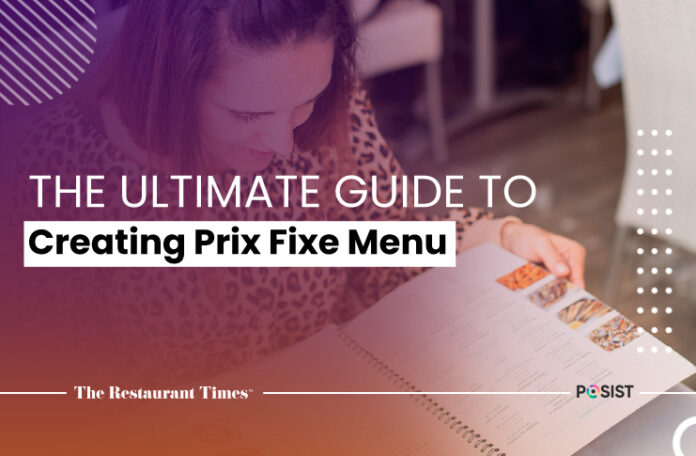Prix fixe menus are becoming increasingly popular in restaurants all over the world. According to the Thrillist author Lia Picard, they might be becoming ‘the new normal’ for restaurants in 2022.
Sitting back and allowing culinary professionals to decide the course of your meal can be enjoyable as well as comforting. In fact, many people think of it as an elevated dining experience altogether.
For the restaurant owners, prix fixe menus are like a breath of fresh air. Based on the principle of ‘less is more’, prix fixe menus can increase the efficiency and speed of your restaurant. So how do you build a prix fixe menu? Here is a quick guide to answer all your prix fixe questions.
What Is A Prix Fixe Menu?
‘Prix fixe’ is a French term that means fixed price, and it is pronounced as pree fiks. A prix fixe menu is a full multi-course meal, offered at a set price. It consists of multiple courses, which are already decided by the chef. That’s why they are also known as ‘set menus’ or ‘tasting menus’. However, sometimes, the guests can customize their order by choosing dishes from the different categories like desserts, appetizers, side dishes, and mains.
Prix fixe menus are very popular on special occasions like Valentine’s Day or events like Restaurant Week. On such occasions, restaurants can use a prix fixe menu to streamline things for a large crowd and a busy kitchen. They are also perfect for catered functions, parties, and serving a packed restaurant.
What Does A Prix Fixe Menu Consist Of, And When Is It Needed?
A prix fixe menu consists of at least three courses, typically an appetizer, entrée, and dessert. However, it may include other categories like soup and salads. The complete menu is offered at a fixed price.
Restaurants can offer as many as three offerings for each section. For example, for the dessert section, you can offer items like an ice cream, a chocolate cake, and a fruit salad to choose from. However, offering more than three options per category can overwhelm the diners, and hence, should be avoided.
Prix fixe menus are used during busy times to control a frantic kitchen. On traditionally busy days, they can give your cooks much-needed time for preparation and can make operations smooth for the restaurant. You can also use prix fixe menus in situations such as:
- On special occasions to set the tone for the day.
- On slow weeknights to bring in diners.
- On specific days to showcase the skills of your chefs.
Different Styles Of Prix Fixe Menu
Different restaurants opt for different variations of prix fixe menus to suit their needs as well as their customers.
Host’s Table
Host’s Table (or Table ďHôte in French) is similar to a prix fixe menu. However, unlike a prix fixe, the price of the entrées can vary in a Host’s table. Diners pay different prices according to the choices they make for every course.
Teishoku
Teishoku is a Japanese style of restaurant service, in which you can offer platters of different kinds of dishes, or meal bundles, from the menu at a fixed rate.
Prix Fixe Lunches
Restaurants can have a hard time attracting customers at lunch, especially if they are neither a go-to spot for business lunches nor a quick-service establishment. However, this is where you can use a prix fixe lunch menu at an eye-catching deal to attract customers for lunch and ramp up your business.
What Are The Benefits Of Prix Fixe Menu?
There are several benefits of a prix fixe menu for restaurant owners as well as their customers.
Creating Buzz For Your Restaurant
Several restaurants use a prix fixe menu as a marketing strategy on a part-time basis. You can use a prix fixe menu to advertise limited-time city-wide events and attract guests on special occasions like holidays, pop culture events, and anniversaries.
The guests will love the feeling of being part of the community, and you can generate some buzz for yourself in the process.
Managing Your Front-of-House And Back-of-House Staff
With a prix fixe menu, your chefs will already know what to cook and prepare. Your servers too will find it much easier to manage orders. With fewer options on the menu, your team can focus on the details of cooking and managing to ensure overall dining quality.
Regulating Costs
When you use a prix fixe menu, you already know the cost of food per diner. You can order only those ingredients that are needed for items on the menu, and save money on your inventory.
You can also reduce your Cost Of Goods Sold (COGS). Cost of goods sold refers to the cost of all the raw materials that go into producing food items for your restaurant. If you can accommodate the price of your most expensive dish within the prix fixe menu, you are bound to make a profit even if the customers go for another (less expensive) option.
You can maximize your profits by figuring out your COGS and using that in your prix fixe menu.
Benefits For The Guests
Customers often become overwhelmed with too many choices. A fixed menu can help the customers by making their decisions for them. Keep your menu simple and straightforward so that the diners have complete clarity about their orders.
With prix fixe menus, diners also get to fulfill their wish of trying out all the items on the menu with a single order.
When customers get multiple courses in their meals for just one order, they feel like they are getting a bargain. Hence, even though the portions of a typical prix fixe menu are smaller than a regular one, diners feel like they are getting more.
Key Considerations When Creating A Prix Fixe Menu
Creating a prix fixe menu from scratch can be tricky. After all, you have to consider multiple factors like texture, aesthetics, and the flavors that you are going to include in the menu. However, if you keep certain tips in mind, you can create the perfect prix fixe menu for the restaurant and charge up your backend management system.
Number Of Courses
The prix fixe menu can have as little as three or as many as ten or more courses. Narrow down the number of courses that your restaurant will offer, and decide the dishes you would like to offer for each course. Most restaurants like to keep it short and sweet with three courses: appetizers, main dishes, and desserts.
Selection Of Dishes
Find out your most popular dishes and put those best-sellers on the prix fixe menu. While you should certainly include a mix of flavors in the menu, try to maintain continuity throughout the courses and make sure that the overall meal is cohesive from start to finish.
Theme
A theme sets certain boundaries around the menu and makes it more creative and cohesive. Some restaurants try the concept of merging different themes for their prix fixe menus too.
You can pick up a seasonal or a geographical theme. You can also pick and name your dishes around the theme of popular cultural events like the Oscars or sporting events like the Olympics.
Simplicity
Restaurants usually use a single sheet to print a prix fixe menu. Use good quality paper and include brief descriptions for each of the dishes. Avoid complicating things too much with clip art or other graphics on the menu.
Fix your menu according to the capacity of your kitchen. Even out the distribution of simple and complex items on the menu to avoid overwhelming the kitchen. There is no point in having too many options if they compromise the quality of the food or the dining experience.
Preparation is vital before beginning any new venture. Make sure your staff has enough time to prepare all the dishes on the menu so that the guests do not have to wait too long for courses to arrive.

















